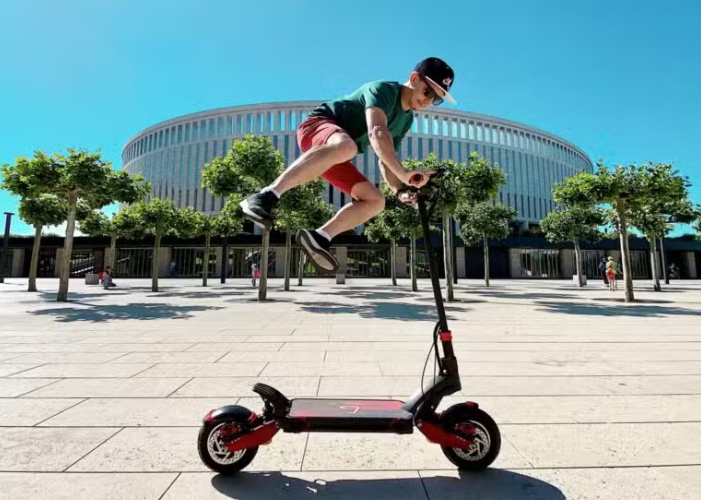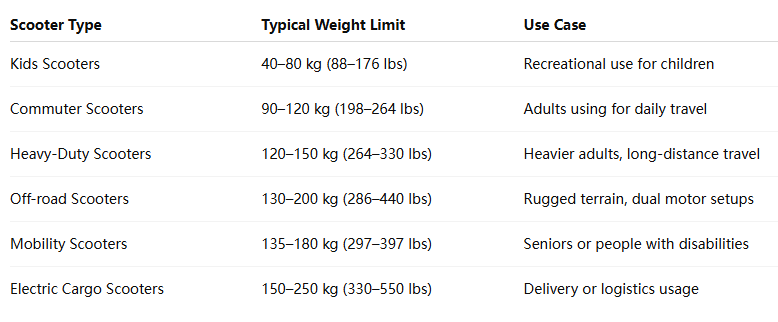Why Is the Scooter Weight Limit Important?
The scooter weight limit is not just a number—it’s a key specification that affects:
- Structural safety: Prevents frame deformation or cracking
- Motor performance: Ensures optimal acceleration and climbing ability
- Battery range: Heavier loads reduce efficiency
- Braking system: Avoids brake strain or failure
- Tire wear and durability: Proper load avoids premature tire wear
Exceeding the scooter weight limit may void the manufacturer’s warranty, reduce lifespan, or even cause accidents.

What Determines the Weight Capacity of a Scooter?
Several engineering and design factors influence the scooter weight limit, including:
a. Frame Material
- Aluminum Alloy: Common, lightweight, moderate capacity (up to 220 lbs / 100 kg)
- Steel: Stronger, heavier, often supports up to 265 lbs (120 kg)
- Carbon Fiber: Lightweight and strong, seen in premium models
b. Motor Power
- Scooters with 250W motors typically support up to 100 kg
- 500W – 1000W motors handle heavier riders up to 120–150 kg
- Dual motor scooters (2000W+ combined) support 150 kg and more
c. Suspension and Tires
- Large pneumatic tires and reinforced suspension systems support greater loads
- Solid tires generally support less weight than air-filled tires
d. Deck Size and Reinforcement
- A longer, reinforced deck improves rider stability and load support
- Deck thickness and subframe bracing matter
e. Braking System
- Stronger brakes (hydraulic or disc) are essential for heavier loads
What Are the Typical Scooter Weight Limits by Type?
Different scooter categories offer varied scooter weight limits:

The scooter weight limit should always exceed the rider’s body weight plus any cargo or backpack weight.
What Happens If You Exceed the Scooter Weight Limit?
Ignoring the specified scooter weight limit can lead to serious issues:
- Reduced Speed and Acceleration: Overload strains the motor
- Shortened Battery Life: Higher current draw due to load
- Frame or Fork Bending: Over time, aluminum or alloy frames may warp
- Flat Tires or Rim Damage: Especially with underinflated air tires
- Brake Overheating or Failure: Brakes may become less responsive under excess weight
Even if the scooter functions with overload, it is unsafe and damaging in the long term.
How to Choose the Right Scooter Based on Rider Weight?
Here’s a simple breakdown of recommended scooter weight limits based on rider profiles:

Always leave at least 10–15% buffer for safety and occasional cargo.
How Does the Scooter Weight Limit Affect Performance?
Performance aspects that change with different scooter weight limits include:
a. Speed and Torque
Heavier riders require more power to achieve the same speed. Underpowered scooters may feel sluggish if the rider is close to or over the limit.
b. Hill Climbing Ability
Low-watt scooters under 300W struggle on inclines with heavier loads. Choose 500W+ for hills if you weigh over 90 kg.
c. Battery Range
The heavier the rider, the more energy the motor consumes. Expect 10–30% reduced range near max weight limits.
d. Braking Distance
Heavier loads increase stopping distance. This requires more powerful braking systems (e.g., hydraulic vs. drum).
Are There Scooters for Overweight or Heavier Riders?
Yes. Many manufacturers now produce heavy-duty electric scooters designed for:
- Riders over 120 kg
- Cargo and delivery purposes
- Off-road exploration
Features to look for:
- Dual motors (500W–1000W each)
- Wide decks
- Large 10–11 inch tires
- Dual suspension
- Scooter weight limits of 150–200+ kg
These scooters are typically more expensive but offer unmatched durability and performance.
How Does Rider Behavior Impact Scooter Load Handling?
Even with a high scooter weight limit, rider behavior can influence safety and longevity:
- Sudden braking or aggressive acceleration increases stress
- Jumping curbs or uneven terrain riding may lead to frame cracks
- Improper tire inflation worsens wear under heavier riders
- Incorrect posture (leaning back excessively) may cause instability
Ride within design intentions, and even a scooter near its weight limit can perform reliably.
Are There Standards or Certifications for Scooter Weight Limits?
Yes. Manufacturers usually test according to:
- ISO 7176 (mobility scooters)
- EN 17128 (electrically powered personal transporters)
- UL 2272 (battery and fire safety)
However, the scooter weight limit is generally self-declared by manufacturers based on internal stress, fatigue, and safety tests. Always buy from certified or reputable brands to ensure the limit is accurately defined.
What Should You Consider If You Carry Cargo or Passengers?
If you frequently ride with:
- A backpack or shopping bag
- Child seat attachment
- Delivery boxes
Then your total load is body weight plus 5–30 kg. You must subtract this from the scooter weight limit to avoid overloading.
Two-seater or cargo scooters often list max combined capacity, which may range from 150 to 250 kg.
How to Maintain a Scooter Near Its Weight Limit?
To keep performance optimal:
- Check tire pressure weekly (especially for pneumatic tires)
- Lubricate moving parts regularly
- Inspect deck and stem bolts monthly
- Monitor brake performance frequently
- Charge battery correctly and avoid deep discharges
High-weight riders may need to replace tires and brake pads more often.
Can You Increase a Scooter’s Weight Limit?
Technically, no. The frame, motor, and components are designed for a specific limit.
However, you can choose:
- Aftermarket suspension upgrades
- Stronger tires
- Battery replacements with higher output
But even with modifications, the original scooter weight limit remains the structural maximum. Going beyond is risky and not recommended.
Final Thoughts: What Scooter Weight Limit Should You Aim For?
When buying a scooter:
- Choose one with 20–30 kg more than your body + cargo
- Review real-world tests and reviews, not just spec sheets
- Prioritize safety and structural integrity over speed or design
- Understand that higher weight limit = higher cost and weight of scooter itself
A scooter is an investment in mobility—make sure it’s sized for your real-world needs, not just marketing claims.
Conclusion: Understanding and Respecting the Scooter Weight Limit Ensures Safety and Longevity
The scooter weight limit is one of the most important specs for any rider. It impacts everything from safety and performance to maintenance and comfort. By selecting the right scooter with a weight limit tailored to your needs, you’re ensuring long-term satisfaction and optimal performance.
If you're exploring reliable scooters built for a wide range of weight capacities and conditions, Zhejiang Dece Power Co., Ltd. is one of the many manufacturers offering durable, export-grade electric scooters worldwide.




Comments